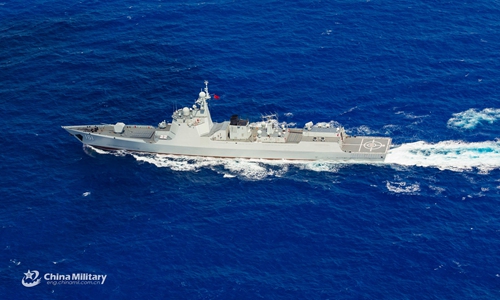HOME >> WORLD
US accusation of Chinese ship using laser beam to hype ‘China threat’: experts
By Guo Yuandan and Liu Xuanzun Source:Global Times Published: 2020/2/28 23:48:40

The guided-missile destroyer Huhhot (Hull 161) attached to a destroyer flotilla with the navy under the PLA Southern Theater Command steams in waters of the South China Sea during a maritime training exercise in Mid-July, 2019. Photo:China Military
Chinese experts clarified on Friday the reason a Chinese Navy destroyer pointed a laser beam at a US navy patrol aircraft near Guam in international waters of the Pacific Ocean earlier in February is to defend its fleet from the US warplane's dangerous close-in reconnaissance, which the US Navy accused on Thursday.
China's military aircraft and vessels will continue to fly, sail and operate anywhere international law allows, and the US accusation is an obvious attempt to hype the "China threat" theory and raise its navy budget, experts said.
A US Navy P-8A Poseidon maritime patrol aircraft was lased by Chinese Navy destroyer Hohhot (Hull 161) on February 17 while flying in airspace above international waters approximately 380 miles west of Guam, according to a statement the US Pacific Fleet released on Thursday.
The laser could potentially cause serious harm to crew and mariners, as well as ship and aircraft systems, the statement claimed, noting the Chinese destroyer's actions were "unsafe and unprofessional," and violated the Code for Unplanned Encounters at Sea (CUES), a multilateral agreement reached at the 2014 Western Pacific Naval Symposium to reduce the chance of an incident at sea.A Chinese naval expert, who asked not to be named, told the Global Times on Friday that the US accusation is groundless, as the Chinese warship was conducting normal training in international waters, and using related equipment during such training conforms to international law.
Compared to the scheduled training by the Chinese warship, the fast approaching US warplane was the aggressive one, the expert said, noting that since vessel-based laser systems have limited effective range, being able to be hit by it only means the US warplane was attempting to conduct a close-in reconnaissance that would interrupt the Chinese fleet's normal navigation and training.
As of press time, the US Pacific Fleet failed to reply to a Global Times inquiry on the distance between the P-8A and Hohhot and what the two were doing when the incident occurred.
The release of the US Pacific Fleet statement came at a time when the US House Armed Services Committee was holding a series of hearings on next year's military budget, and planned funds for the US Navy were being reduced.
The laser accusation is again aimed at getting a bigger budget for the US Navy, analysts said.
Zhang Junshe, a senior research fellow at the PLA Naval Military Studies Research Institute, told the Global Times on Friday that the US is again making noise to hype the "China threat" theory and interrupt the Chinese Navy's normal maritime training.
US patrol aircraft have been frequently flying over other countries' warships and interrupting their normal activities, Zhang said, noting that Russia said US warplanes often turn off their radar transponders on purpose and fly on the same height and route as a civilian aircraft, posing a threat to other countries.
The US Pacific Fleet statement said US Navy aircraft and ships will continue to fly, sail and operate anywhere international law allows, but that goes the same for the Chinese Navy, experts said.
Hohhot, the Chinese destroyer mentioned by the US statement, was part of the Chinese far sea joint training of the Chinese People's Liberation Army Southern Theater Command.
The fleet consisted of other warships, including guided missile frigate Xianning, electronic surveillance ship Tianshuxing and replenishment ship Chaganhu, and successfully completed on Tuesday the 41-day training mission that saw it sailing 14,000 nautical miles and crossing the International Date Line deep into the Pacific Ocean for the first time.
The Chinese fleet conducted more than 30 training exercises, including live-ammunition fire of main and secondary guns, missiles, wartime replenishment and far sea comprehensive rescue.
Beijing-based naval expert Li Jie told the Global Times that the US has always thought of itself as a major influence in these open waters and usually does not want foreign warships to enter them, but the Chinese fleet will break this conventional thinking and hegemony and sail more frequently and farther.
RELATED ARTICLES:
Posted in: ASIA-PACIFIC